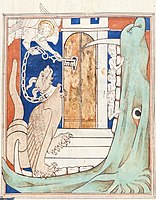Hellmouth

A Hellmouth, or the jaws of Hell, is the entrance to

The Hellmouth was intended to remind a Christian audience of the danger of
History

The oldest example of an animal Hellmouth known to
Satan swallowing the damned
In the Anglo-Saxon
... ne cumaþ þa næfre of þæra wyrma seaðe & of þæs dracan ceolan þe is Satan nemned. [they] never come out of the pit of snakes and of the throat of the dragon which is called Satan.[8]
Association with Leviathan
The whale-monster
The whale has another trick: when he is hungry, he opens his mouth and a sweet smell comes out. The fish are tricked by the smell and they enter into his mouth. Suddenly the whale's jaws close. Likewise, any man who lets himself be tricked by a sweet smell and led to sin will go into hell, opened by the devil—if he has followed the pleasures of the body and not those of the spirit. When the devil has brought them to hell, he clashes together the jaws, the gates of hell. No one can get out from them, just as no fish can escape from the mouth of the whale.[9]
Association with Cerberus
Later in the Middle Ages, the classical Cerberus also became associated with the image, although it is hardly likely that the Anglo-Saxons had him in mind.[10]
Hellmouth as the mouth of Satan
Satan himself is often shown sitting in Hell eating the damned, but according to G.D. Schmidt this is a separate image, and the Hellmouth should not be considered to be the mouth of Satan, although Hofmann is inclined to disagree with this.[11] The Hellmouth never bites the damned, remaining wide open, ready for more.
Decline of the motif in the Late Middle Ages
In general the motif had fallen from favour in Italy and the Netherlands by the late 14th century, and is rarely seen in the many Last Judgements in
Gallery
-
Hellmouth, locked by an archangel, from the Winchester Psalter of about 1150
-
Hell Mouth or Jaws of Hell, Bourges Cathedral, ca. 12th century
-
Queen Mary Apocalypse—BL Royal MS 19 B XV f. 38v Angel with key and dragon, 1st qtr 14th century
-
Simplified Last Judgment fromLes Très Riches Heures du duc de Berry, c. 1440s
-
El Greco, The Adoration of the Name of Jesus, 1578–80, National Gallery
Citations
- ^ Example by Cranach, 1545
- National Gallery, London)image Archived 2009-05-07 at the Wayback Machine, The Dream of Philip II or Allegory of the Battle of Lepanto (Escurial).image
- ^ from first external link
- ^ The Ecclesiological Society Archived 2008-05-27 at the Wayback Machine Dooms and the mouth of hell in the late medieval period with pictures including two Renaissance stagings.
- ISBN 9780231195515.
- ISBN 0-7011-2514-4 JSTOR
- ^ "The Anglo-Scandinavian Hogback: A Tool for Assimilation". Archived from the original on 2008-08-17. Retrieved 2008-07-10.
- ^ Hofmann, 85
- ^ "translation by Michael DC Drout". Archived from the original on 2008-05-06. Retrieved 2008-07-10.
- ^ Hofmann, 148
- ^ Hofmann, 85
General references
- Hofmann Petra (2008). Infernal Imagery in Anglo-Saxon Charters. PhD thesis. St Andrews, Fife, Scotland: University of St Andrews. OCLC 944163293.
Further reading
- Schmidt, G. D. The Iconography of the Mouth of Hell: Eighth-Century Britain to the Fifteenth Century, 1995, Selinsgrove, PA, Susquehanna University Press, 1995, ISBN 0-945636-69-5
- Simmons, Austin. The Cipherment of the Franks Casket (PDF). Hellmouth (or the whale as constituting Hell) is inferred in the inscription on the front side of the Franks Casket.
External links
 Media related to Hellmouth at Wikimedia Commons
Media related to Hellmouth at Wikimedia Commons





